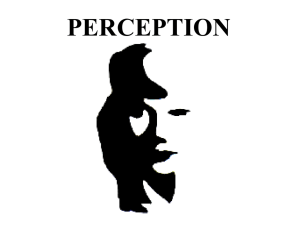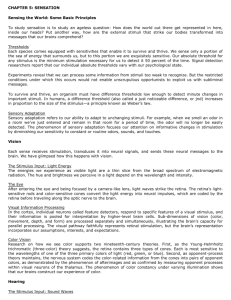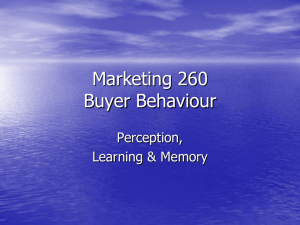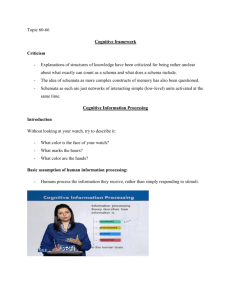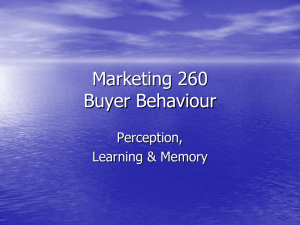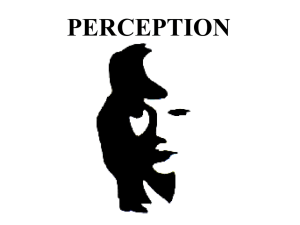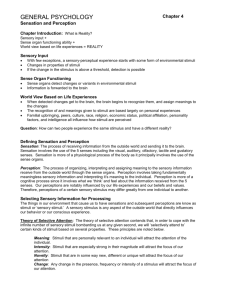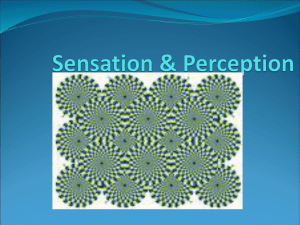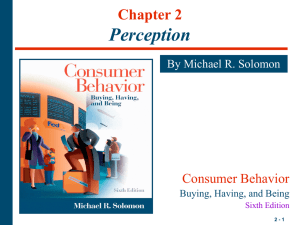Ch 2 Perception
advertisement
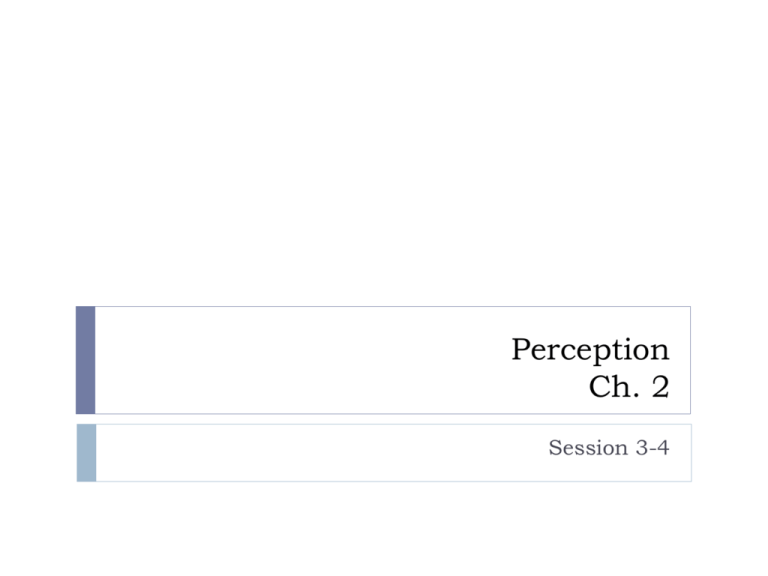
Perception Ch. 2 Session 3-4 Overview of the Perceptual Process Sensation: Exposure: The extent to which we (our brains) devote processing activity to a particular stimulus Interpretation: Occurs when a stimulus comes within the range of someone’s sensory receptors Attention: The immediate response of our sensory receptors (eyes, ears, nose, mouth, fingers) to basic stimuli such as light, color, sound, odors, taste and textures The meaning that we assign to sensory stimuli Perception: The process by which sensations are selected, organized, and interpreted Overview of the Perceptual Process Sensory Systems External stimuli, or sensory inputs, can be received on a number of different channels Inputs picked up by our five senses are the raw data that triggers the perceptual process Sensory branding Paying extra attention to the impact & interplay of various sensations on our product experiences Sensory signature (Read: Brand Sense by Martin Lindstrom) Car Ad Trying to Appeal to All Senses Vision Stimulated through: design, size, shape, colors (visual elements) of packaging, product design, advertising, store design (visual channels) Examples: Coca-Cola bottles have a unique contoured shape Banks use ‘blue’ as it depicts ‘corporate culture’ globally 3M Post-it Notes have a registered canary yellow color Shape of Hershey’s Kisses Examples: Hardee’s Thickburgers have their appeal in size & juiciness Olper’s milk used ‘red’ to differentiate its packaging Tall thin glasses look more voluminous than short broad ones Size of plate also determines how much we eat Older people see colors as more dull (with yellow tinge) Warmer & darker colors incite activity & excitement and cool colors bring relaxation Meat needs to be brown enough Smell It’s a chemical sense so forms strong bonds Examples: Starbucks & the aroma of freshly brewed coffee Dunkin Donuts & the smell of freshly baked doughnuts New car smell (spray) Scratch & sniff ads for perfumes Smell of food cooked in ghee (portrayed in ads) People spend more time in nice-smelling stores Hearing Examples Sound affects moods; fast music energizes, slow music relaxes (concept used in stores & restaurants) Spoken words/speech has unique meanings & effects (brand names) Sound effects used in advertising (jingles, signature tunes) May signify product attributes/quality ‘Sizzle’ of a steak Crunch of cornflakes Taste It’s a chemical sense so may affect on a deeper level Examples Taste houses create & test flavors everyday (Murree Brewery) Taste sampling of food & drink items try to create customer pull Cigarette ads stress on ‘taste’ of smoke Backfired in New Coke’s case Touch Examples: Contoured Coca-Cola bottle identifiable in the dark Perfume bottles are always glass (have tactile appeal) Value of cloth/material associated with how they ‘feel’ People prefer touching products before buying (unpopularity of online buying) Ads for men’s shaving razors (smooth skin gets love) Important Concepts in ‘Exposure’ Marketers (at the basic level) try to increase the likelihood of exposure of their brand Factors that may influence exposure include: Exposure is selective Position / placement of communication within media / contact points Product distribution & shelf placement Zipping zapping on electronic media, pop-up blockers on internet Measures of exposure include People-meters (TV) - viewership Traffic counters (outdoor) - OTS Important Concepts in ‘Exposure’ Absolute Threshold: The minimum amount of stimulation that can be detected on a given sensory channel Important in selecting font / image size, background music levels, intensity of fragrance in stores, etc. Also important when you ‘don’t’ want people to notice something Important Concepts in ‘Exposure’ Differential Threshold: The ability of a sensory system to detect changes / differences between two stimuli The minimum difference that can be detected between two stimuli = j.n.d. (just noticeable difference) Important in reference pricing, change in product sizes, change in serving size, amount of discounts Weber’s Law: The amount of change that is necessary to be noticed is directly related to the intensity of the original stimulus Important Concepts in ‘Attention’ Attention is selective Personal selection factors (relevance, experiences, habituation) Stimulus selection factors (size, color, position, novelty of idea, etc.) Attention can be divided (multi-tasking) We attend to only a small portion of the stimuli to which we are exposed (perceptual selection) We select based on Need for repetition / reinforcement Attention is limited Unfamiliarity reduces division of attention to many stimuli Standardized store design (Gourmet) Important Concepts in ‘Interpretation’ Two people can be exposed to the same stimulus, attend to it but interpret it in very different ways depending on the schema (set of beliefs to which we assign the stimulus) evoked by the stimulus We use different criteria to evaluate the product, message or package Warm tetra-packaged milk in US holds a different meaning than in Pakistan Food cooked in Ghee may hold different meanings for people Concept of ‘family restaurant’ doesn’t appeal to youth Djuice ads Sooper ‘disco’ ad – what schema does it evoke? Important Concepts in ‘Interpretation’ Marketers also use ‘symbolism’ to give desired meaning to products & create product image

